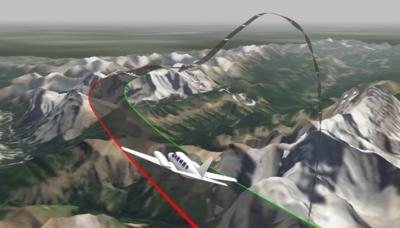Sat, Aug 03, 2019
Piper PA-31 Collided With Terrain In Kananaskis Country, Alberta
In the release of its investigation report (A18W0116), the Transportation Safety Board of Canada (TSB) found that hypoxia ... in-flight oxygen deprivation ... likely played a role in the loss of control that resulted in a fatal 2018 aircraft accident over Mount Rae, Alberta.

In the afternoon of 1 August 2018, after completing two hours of survey activities, an Aries Aviation International Piper PA-31 aircraft was proceeding to Calgary/Springbank Airport Alberta (CYBW), at 15,000 feet above sea level (ASL), with a pilot and a survey technician on board. Approximately 40 nautical miles southwest of the airport, air traffic control began sequencing the aircraft for arrival into the Calgary airspace. At this time, for reasons that could not be determined, the right engine began operating at a significantly lower power setting than the left engine. About 90 seconds later, at approximately 13,500 feet, the aircraft departed controlled flight. The aircraft collided with terrain near the summit of Mount Rae at 13:36 (MDT). The pilot and survey technician were both fatally injured.
The investigation determined that, although a portable oxygen system was activated and available, the pilot was not continuously using oxygen while the aircraft was above 13,000 feet ASL, as required by regulation, and likely became hypoxic. Although hypoxia can cause pronounced performance degradations, its onset can be slow and gradual, making it likely the pilot did not recognize the symptoms, and thus took no action to restore his supply of oxygen. The investigation also found that if flight crews do not undergo practical hypoxia training, there is a risk they will not recognize its onset when flying above 13 000 feet without continuous use of supplemental oxygen.
The aircraft was not equipped with a flight data recorder or cockpit voice recorder, nor were these required by regulation. However, the aircraft was equipped with a flight data monitoring system that included a camera. This system provided significant information to help TSB investigators better understand the underlying factors that contributed to the accident.
(Source: TSB news release. Image from TSB Report)
More News
DETRESFA (Distress Phrase) The code word used to designate an emergency phase wherein there is reasonable certainty that an aircraft and its occupants are threatened by grave and i>[...]
"General aviation is at the forefront of developing and introducing innovative technologies that will transform the entire aviation industry..." Source: Kyle Martin, Vice President>[...]
Direct Straight line flight between two navigational aids, fixes, points, or any combination thereof. When used by pilots in describing off-airway routes, points defining direct ro>[...]
Aero Linx: Women in Corporate Aviation Women in Corporate Aviation support individuals seeking career advancement and professional development in the business aviation industry. Me>[...]
“We would like to thank the many volunteers that help throughout the year to pull off the event, as well as the several reviewers, judges, and SURVICE staff that provide team>[...]
 ANN's Daily Aero-Term (04.26.24): DETRESFA (Distress Phrase)
ANN's Daily Aero-Term (04.26.24): DETRESFA (Distress Phrase) Aero-News: Quote of the Day (04.26.24)
Aero-News: Quote of the Day (04.26.24) ANN's Daily Aero-Term (04.27.24): Direct
ANN's Daily Aero-Term (04.27.24): Direct ANN's Daily Aero-Linx (04.27.24)
ANN's Daily Aero-Linx (04.27.24) Aero-News: Quote of the Day (04.27.24)
Aero-News: Quote of the Day (04.27.24)



